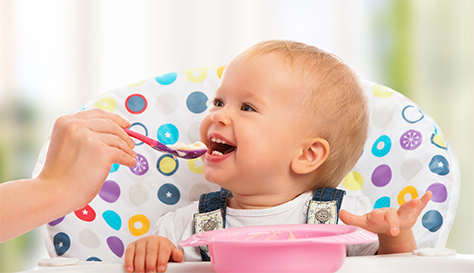
What is spoon-led weaning?
Spoon-fed weaning (SFW) involves you spoon feeding your baby smooth mashed food or purees, progressing to thicker mashed foods with soft lumps and then onto minced and chopped food from around 9 months. Solid finger foods can be introduced alongside spoon feeding right from the beginning or after a couple of weeks once your baby is managing food in their mouth well. This differs from baby-led weaning where instead of feeding your baby, you allow them to feed themselves, exploring solid foods at their own pace.
How does spoon-fed weaning work?
Quite simply you choose soft first foods and turn into a smooth mash or purée which can then be fed to your baby with a spoon. To get them started try mashed cooked vegetables (carrot, sweet potato, parsnip or yam) of mashed fruit like banana, pear or cooked apple. It is also recommended that you give slices of these as finger foods to try alongside as well.
What are the advantages of spoon-fed weaning my baby?
Spoon-fed weaning comes with a few advantages including:
- More food more quickly - your baby can get their food as quickly as they want it if you go at their pace. This is satisfying for them when they are hungry. And they will eat more because it is easier for them to begin eating smooth food
- Less mess – It goes without saying that allowing your little one to only feed themselves can result in some very messy situations at the dinner table. With spoon-fed weaning and some finger foods as well you can ensure most of it is going into their mouth not on the floor! But it is important you encourage you baby to touch and play with the food as well. It helps them learn about food.
- You’ll know how much they’ve eaten – By creating your own mashes or purees you know exactly what is going into them and what nutrients and vitamins you’re giving your baby. Also, if you’re helping to feed them, you can be sure they’re actually eating the food you’ve prepared rather than playing with it
- Less chance of choking – If you begin with smooth food and then move onto thicker mash with soft lumps you are giving your baby time to learn how to manage increasingly more difficult food textures at their own pace
What are the downsides of spoon-fed weaning?
There are a few factors you may want to consider when deciding whether to wean your baby using the spoon-fed method:
- It is difficult for you to eat at the same time as your baby because often babies are spoon fed before the rest of the family eats – but you can still include your baby at the family meal and give them some finger foods to play with and try
- Can require more prep – as you need to mash or puree food
How do I go about spoon-fed weaning?
When it’s time to start spoon-fed weaning you’ll need a few weaning items to make sure the process is as easy (and tidy!) as possible.
If you’re unsure on what to feed your baby, there are plenty of weaning recipes available. The great thing with mashes and purées is that you can put exactly what you want into them to ensure your baby is trying lots of new foods and getting all the nutrients they need.
Once you’ve got your mash or purée prepared it’s simply a case of spoon feeding your baby, giving them time to properly swallow the mouthful before proceeding with the next. This might take a bit of time to begin with until you’re both in a routine and using a technique that works for both of you.
Is spoon-fed weaning the safer option?
Some mums worry their baby might choke if they offer finger foods. It’s true that with spoon-fed weaning you can control the amount of food your baby is putting into their mouth and so may well reduce any chance of choking. But it is important to offer finger foods as well so that your baby learns about foods by seeing them and touching them. Just remember to cut small fruit like grapes in half and remove any stones or pips and your baby should be safe. It’s vital you always stay with your baby while they’re eating in case they choke. Find out more about weaning and food safety.